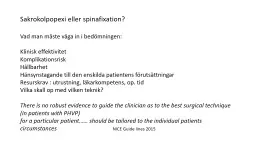

Vad man måste väga in i bedömningen Klinisk effektivitet Komplikationsrisk Hållbarhet Hänsynstagande till den enskilda patientens förutsättningar Resurskrav utrustning läkarkompetens op tid ID: 911324
Download Presentation The PPT/PDF document "Sakrokolpopexi eller spinafixation" is the property of its rightful owner. Permission is granted to download and print the materials on this web site for personal, non-commercial use only, and to display it on your personal computer provided you do not modify the materials and that you retain all copyright notices contained in the materials. By downloading content from our website, you accept the terms of this agreement.
Slide1
Sakrokolpopexi
eller
spinafixation
?
Vad man måste väga in i bedömningen:
Klinisk effektivitet
Komplikationsrisk
Hållbarhet
Hänsynstagande till den enskilda patientens förutsättningar
Resurskrav : utrustning, läkarkompetens, op. tid
Vilka skall
op
med vilken teknik?
There
is no robust
evidence
to guide the
clinician
as to the best
surgical
technique
(in patients
with
PHVP)
for a
particular
patient……
should
be
tailored
to the
individual
patients
circumstances
NICE Guide
lines
2015
Slide2Barber,Maher
.
Systematic
review
Int
Urogyn
J 2013. 1229
pat
SSF:
Anatomical
sucess
rate 64-97%
Obj
failure
at
any
site
postop
28.8%
Anterior
wall
failure
21.3%
Apical
failure
7.2%
Reop
1.3-37% (
samtl
studier utan 2
st
<9%)
Symomatisk
relief 89.7%
Allvarlig blödning 0.2%
Buttock
pain 3% (<15%
Barber JAMA 2014
)
ASC/LSC: Lack
of
postop
apical
prolapse
78-100%
No
recurrent
prolapse
in
any
compartment
56-100%
Reop
rate 4.4%
”
Level
I
evidence
that
ASC has
superior
anatomical
outcomes
compared
to SSF”
Too
few
published
data to
allow
an
evidence
based
decision
about
which
patient….
will
be best
served
with
ASC relative to
other
tecniques
”
CARE-trial.
Nygaard
I. JAMA. 2013. 233
pts
5 års uppföljning: 30-36%
had
either
symtomatic
recurrence
or
were
reoperated
Slide3Hill A. Barber M:
review
C
urrent
opinion 2015
ASC:
probability
for
failure
may
be as
high
as 48% at 7 yrs
Mesh
exposure 10.5% at 7
years
(
some
were
operated
with
non-optimal
mesh
)
Ökad risk för
mesh
complications
om
stage
III prolaps el mer, samtidig
hysterektomi
och mer än 3 samtidigt utförda åtgärder
LSC: no
diff
compared
to ASC bortsett från
komplik
rat 20.0% ASC vs 12.7% LASC
LSC/R-LSC: R-LSC längre
op
tid, högre kostnad (c:a 2000 dollar i skillnad
pga
längre
op
tid)
Ingen skillnad när avskrivningskostnader och underhållskostnader subtraherats.
Likvärdiga kostnader om
op
tiden <149 min
Cochrane
database
review
2016.
Surgery
for
women
with
apcal
vaginal
prolapse
. Maher C
30
RCT:s
, 3414
pts
Sacral
colpopexy
is
associated
with
lower
risk
of
awareness
of
prolapse
(7 vs 7-27%),
recurrent
prolapse
on examination ,
repeat
surgery
for
prolapse
(4 vs 5-18%), postoperative SUI and
dyspareunia
than
a
variety
of
vaginal interventions.
We
found
no
conclusive
evidence
that
vaginal
procedures
increases
the risk for
repeat
surgery
of
SUI (2-16%)
Slide4Hill A. Barber M:
review
C
urrent
opinion 2015
ASC:
probability
for
failure
may
be as
high
as 48% at 7 yrs
Mesh
exposure 10.5% at 7
years
(
some
were
operated
with
non-optimal
mesh
)
Ökad risk för
mesh
complications
om
stage
III prolaps el mer, samtidig
hysterektomi
och mer än 3 samtidigt utförda åtgärder
LSC: no
diff
compared
to ASC bortsett från
komplik
rat 20.0% ASC vs 12.7% LASC
LSC/R-LSC: R-LSC längre
op
tid, högre kostnad (c:a 2000 dollar i skillnad
pga
längre
op
tid)
Ingen skillnad när avskrivningskostnader och underhållskostnader subtraherats.
Likvärdiga kostnader om
op
tiden <149 min
Cochrane
database
review
2016.
Surgery
for
women
with
apcal
vaginal
prolapse
. Maher C
30
RCT:s
, 3414
pts
Sacral
colpopexy
is
associated
with
lower
risk
of
awareness
of
prolapse
(7 vs 7-27%),
recurrent
prolapse
on examination ,
repeat
surgery
for
prolapse
(4 vs 5-18%), postoperative SUI and
dyspareunia
than
a
variety
of
vaginal interventions.
We
found
no
conclusive
evidence
that
vaginal
procedures
increases
the risk for
repeat
surgery
of
SUI (2-16%)
Slide5Coolen
A-L.
Int
Urogyn
J 2017.
Systematic
review
of
surgery
for PHVP 9
RCT´s
. 846
pat
SuccessfulAnatomical
results
: ASC-LSC-RLSC 62-91%
Vaginal
mesh
43-97
SSF
35-81
Reop
for POP
ASC
0-3
%
LSC
4-11
SSF
5-27
Vaginal
mesh
0-5
Reop
for
complications
/GSUI ASC 6-19%
LSC
6-19
SSF
5-27
Vaginal
mesh
13-31
Dyspareunia
ASC
20
%
SSF
3-19
Vaginal
mesh
6
”
Differences
were
negligible. A standard
treatment
for PHVP
could
not be given
according
to
this
review
Slide6ACOG
practice
bulletin. 2017
ASC:
significantly
greater
likelyhood
of
anatomic
successwith
mesh
ASC
compared
with
vaginal
apex
repair
with
native
tissue
( O.R.2.04)
Increased
risk for
surgical
complications
with
ASC
compared
to vaginal
native
tissue
repair
(
2.7 vs
0.2
%).
Significant
reoperation rate for
mesh
complicatons
with
ASC (10.5%)
LSC:
longer
op-time
,
increased
post-
op
pain and
increased
cost
Candidates
for ASC
include
those
with
a
shortened
vaginal
length
, intra-abdominal
pathology
or risk
factors
for
recurrent
POP (<60 yrs,
stage
III-IV
prolapse
or BMI > 26)
Slide7RCOG (NICE-
gudelines
) 2015
Surgical
treatment
for Post
Hysterectomy
Vault
Prolapse
(PHVP)
Prevention: McCall
culdoplasty
and
suturing
the vaginal
cuff
to the
cardinal
and
sacrouterine
ligaments
are
effective
in preventing PHVP in
both
abdominal and vaginal
hysterectomies
.
SSF at the
time
of
vaginal
hysterectomy
should
be
considered
when
the
vault
descends
to the
introitus
during
closure
Both
ASC and SSF
are
effective
treatments
for
primary
PHVP (Post
H
ysterectomy
Vault
Prolapse
) .
ASC is
associated
with
significantly
lower
rates
of
recurrent
vault
prolapse
,
dyspareunia
and GSUI
when
compared
to SSF.
However
this
is
not
reflected
in
significantly
lower
reoperation rates or
higher
patient
satisfaction
.
SSF
may
not be
appropriate
in
women
with
a
shortened
vagina or in
women
with
pre-
existing
dyspareunia
There
is no robust
evidence
to guide the
clinician
as to the best
surgical
technique
for a
particular
patient
The
type
of
operation
performed
should
be
tailored
to the
individual
patient´s
circumstances
such
as
concomitant
prolapse
in
other
compartments
, sexual
activity
,
previous
abdominal
surgery
, the total vaginal
length
and
associated
comorbidities
.